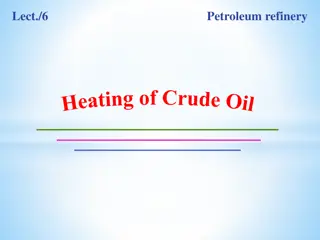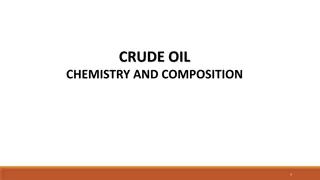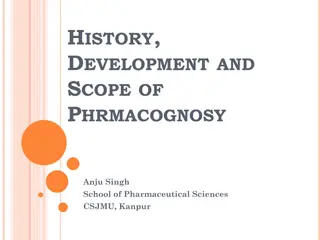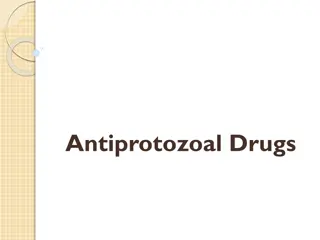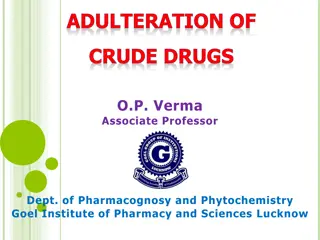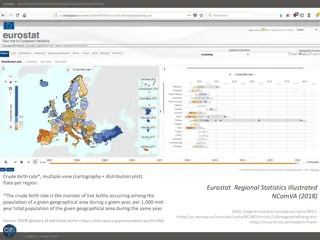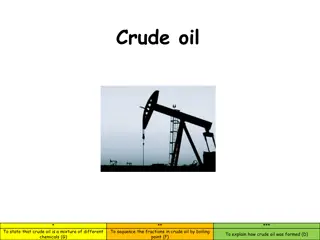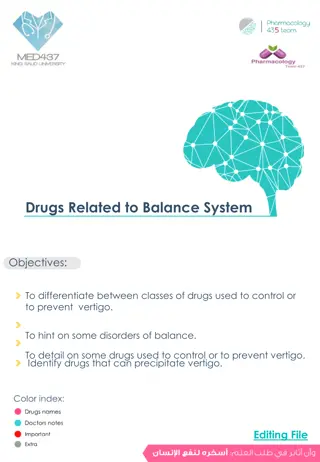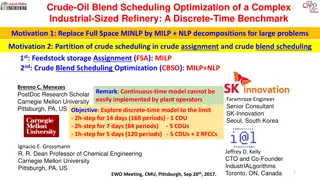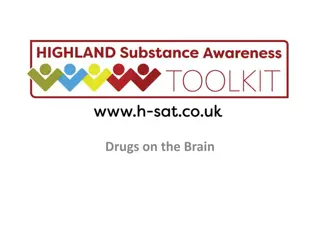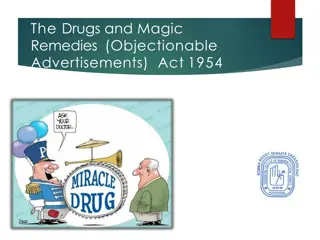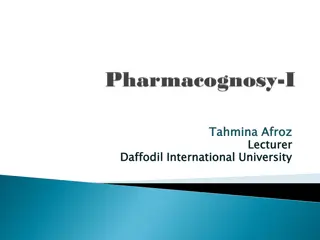Heating of Crude Oil
The process of heating crude oil in petroleum refineries involves various types of furnaces and heat distribution methods. The furnaces can be categorized into box, cylindrical, and radiant wall types, each with separate radiation and convection sections. Design considerations include heat transfer
1 views • 24 slides
Occupational Exposure to Hazardous Drugs: Risks and Prevention
Learn about the hazards of exposure to hazardous drugs, including potential health risks such as cancer, nausea, reproductive toxicity, and organ damage. Explore training modules, drug categories, and a list of hazardous drugs to ensure workplace safety. Discover NIOSH criteria for identifying hazar
1 views • 42 slides
Overview of Drugs and Cosmetics Act, 1940
The Drugs and Cosmetics Act of 1940 was enacted to regulate the import, manufacture, distribution, and sale of drugs and cosmetics in India. The Act aims to ensure high standards of medical treatment, prevent substandard drugs, and establish advisory boards for different types of drugs. It sets out
0 views • 49 slides
Sources of Crude Drugs: Plant, Animal, Marine, and Tissue Culture in Pharmacognosy
Crude drugs are natural substances obtained from plants, animals, and minerals. They are used without much processing and have therapeutic properties. Different plant parts like leaves, flowers, fruits, seeds, roots, bark, and stems yield various important drugs. Animals and minerals also serve as s
1 views • 19 slides
The Drugs and Magic Remedies (Objectionable Advertisements) Act, 1954 Overview
The Drugs and Magic Remedies (Objectionable Advertisements) Act of 1954 regulates the advertising of drugs and remedies claiming magical properties in India. It defines drugs and magic remedies, prohibits certain types of advertisements related to drugs, and aims to control misleading marketing prac
0 views • 12 slides
Overview of Drugs and Cosmetics Act, 1940 and Its Rules 1945
The Drugs and Cosmetics Act of 1940 and its Rules of 1945 were established to regulate the import, manufacture, distribution, and sale of drugs and cosmetics in India. The Act ensures that only qualified individuals are involved in these processes and aims to prevent the entry of substandard or spur
0 views • 116 slides
Understanding the Chemistry and Composition of Crude Oil
Crude oil, also known as petroleum, is a complex mixture of hydrocarbons and other compounds like sulfur, nitrogen, and metals. The composition of crude oil includes aliphatics, aromatics, naphthenes, and other elements, each playing a unique role in its properties and characteristics. This article
1 views • 12 slides
Saudi Arabia's Energy Transition and Crude Oil Exports Analysis
The presentation explores Saudi Arabia's reliance on oil windfalls for economic prosperity, challenges posed by global energy transition, and the impact on crude oil exports. It highlights the country's evolving role in the global oil market, emphasizing the need to adapt to shifting energy demands
1 views • 26 slides
Overview of Anxiety Disorders and Antianxiety Drugs
Anxiety disorders are conditions characterized by excessive worry and fear that can interfere with daily life. Common types include generalized anxiety disorder, panic disorder, phobias, and OCD. Treatment options include psychotherapy and anxiolytic drugs such as benzodiazepines, 5HT1A agonists, be
0 views • 25 slides
Overview of Anticestodal Drugs in Veterinary Pharmacology
Anticestodal drugs play a crucial role in combating tapeworm infections in veterinary medicine. These drugs are classified into taeniafuges and taenicides, with examples of natural and synthetic compounds highlighted. Natural compounds like pumpkin seeds and male fern are traditionally used for thei
0 views • 29 slides
Overview of Central Drug Standard Control Organisation (CDSCO) in India
The Central Drug Standard Control Organisation (CDSCO) is the main regulatory body in India for pharmaceuticals, medical devices, and clinical trials. It functions under the Directorate General of Health Services, Ministry of Health and Family Welfare, Government of India. The CDSCO is responsible f
0 views • 18 slides
Understanding Generic Drugs and Brand Name Medications
Generic drugs are identical copies of brand-name medications in dosage, strength, quality, and intended use. They contain the same active ingredients but are sold under their chemical name. This article explores the basic differences between generic and brand-name drugs, when generic drugs are marke
0 views • 20 slides
History, Development, and Scope of Pharmacognosy
Pharmacognosy is the study of medicinal uses of crude drugs obtained from plants and natural resources. It involves researching physical, chemical, and biological properties of drugs from natural sources. The history of pharmacognosy dates back to prehistoric times, where the use of medicinal plants
0 views • 17 slides
Overview of Antitubercular Drugs: Introduction, Classification, and Applications
Tuberculosis is a chronic granulomatous disease caused by Mycobacterium bovis in ruminants and Mycobacterium avium in dogs and pigs. These bacteria have a unique waxy appearance due to their cell wall composition, providing a shield against pharmacological compounds. Antitubercular drugs play a cruc
3 views • 28 slides
Understanding Renal Block: Drugs, Excretion, and Treatment Essentials
Renal block plays a crucial role in drug excretion, with processes like glomerular filtration and tubular secretion affecting drug elimination. Factors like blood flow, physiochemical properties, and urine pH influence renal excretion of drugs. Competition between drugs for transporters can have ben
0 views • 10 slides
Advances in Antimicrobial Drugs: Selective Toxicity and Classification
The development of antimicrobial drugs has significantly improved therapeutics by controlling infections and preventing complications. These drugs target invading microorganisms using selective toxicity, sparing host cells. Antimicrobial drugs are classified based on site, mechanism of action, and c
0 views • 30 slides
Classification of Drugs Acting on Central Nervous System
The Central Nervous System (CNS) plays a crucial role in coordinating the body's functions and responses to the environment. Drugs acting on the CNS can be classified into CNS stimulants and CNS depressants. CNS stimulants include spinal, medullary, and cortical stimulants, with various direct and i
0 views • 10 slides
Understanding Antiprotozoal Drugs: A Brief Overview
Protozoal infections are widespread, impacting both developed and underdeveloped regions due to globalization. Antiprotozoal drugs are crucial for treating diseases like malaria, amebiasis, and more. However, these drugs can have potent toxic effects on host cells. This article delves into the class
0 views • 29 slides
Role of Crude Oil in Organic Chemistry and Energy Production
Crude oil, the traditional starting material of organic chemistry, is predominantly used for energy production with less than 2% utilized for making plastics, road tar, and other tangible products. This resource-intensive process involves pumping over 1.3 trillion gallons of oil annually, equivalent
6 views • 4 slides
Understanding Quality Control of Drugs of Natural Origin
This chapter delves into the various methods of detecting adulteration in crude drugs, with examples and evaluation techniques to preserve their quality. It discusses deliberate and unintended forms of adulteration, their detection methods, and reasons behind deliberate adulteration. The content emp
3 views • 12 slides
Oil Industry Segment Update and Production Trends Overview
The oil industry segment is experiencing fluctuations in production and prices, as indicated by recent data on WTI and Brent prices, US crude oil production, tight crude oil production, Williston Basin crude oil production, US land rig count for oil, and total US and Canada CBR. The updates highligh
2 views • 9 slides
Overview of Oil Industry Segment Update and Global Production Trends
This update covers the latest insights on the oil industry segment, including global production and consumption trends, total US refinery capacity and crude oil production, North American crude by rail origins and destinations, ND production modal share, and products of petroleum refining transporte
0 views • 7 slides
Pharmacology of Ovulation-Inducing Drugs
Understanding the mechanism of ovulation and hormonal regulation is key in classifying drugs used to induce ovulation. This lecture covers the pharmacology of different groups of drugs, their mechanisms of action, administration protocols, indications, efficacy rates, and adverse effects. Antiestrog
0 views • 6 slides
DAVA Drugs Authentication & Verification Application by National Informatics Centre
The DAVA Drugs Authentication & Verification Application, developed by the National Informatics Centre of the Government of India, enables authentication, tracking, and tracing of Indian drugs at different packaging levels. Manufacturers maintain Unique Serial Numbers for primary and secondary packa
2 views • 42 slides
Comprehensive Review of Drugs, Categories, and Drug Influence Evaluation
This mid-course review covers key aspects such as defining drugs, naming drug categories and subcategories, identifying drug categories for specific drugs, components of drug influence evaluation, and examinations conducted as part of the evaluation process. The content also includes identifying dru
0 views • 28 slides
Introduction to Practical Pharmacognosy: Study of Medicines from Natural Sources
Pharmacognosy is the study of medicines derived from natural sources, exploring drugs from plants through the lenses of botany, chemistry, and pharmacology. This includes the classification of vegetable drugs based on taxonomic, chemical, and morphological characteristics. Understanding key points f
0 views • 19 slides
Insights from the 55th Annual South Dakota Asphalt Conference
The 55th Annual South Dakota Asphalt Conference held in Pierre, SD in April 2016 brought together agencies, industry, and academia to discuss the future outlook of crude oil prices and the trajectory of asphalt pavement in South Dakota post-2000. Key topics included investment in crude oil, market b
0 views • 17 slides
Understanding the Impact of Drugs on Pregnancy Development
This lecture covers factors influencing placental transfer, harmful effects of drugs at different developmental stages, FDA classifications of drugs, and teratogenic drugs. It explains how drugs cross the placenta, including physiochemical properties and stage of development affecting transfer. The
0 views • 10 slides
Understanding Adulteration of Crude Drugs
Adulteration of crude drugs involves substituting the original substance with similar-looking but chemically inferior ones. This deceptive practice can be intentional or accidental, driven by factors like profits, scarcity, or high prices in the market. Different types and reasons for adulteration a
0 views • 36 slides
Visualization of Crude Birth Rates in European Regions
Explore the visualization of crude birth rates in different European regions using cartography and distribution plots. The data, sourced from Eurostat Regional Statistics, illustrates variations across regions, with France showing both the lowest and highest rates relative to other European countrie
0 views • 4 slides
Understanding Age Adjustment in Disability Statistics
Explore the significance of age adjustment in disability statistics for creating comparable figures across countries. Learn about crude versus age-adjusted prevalence estimates and the importance of standardized rates for accurate comparisons in different populations. Discover the anatomy of rates,
0 views • 22 slides
Understanding Crude Oil and Fractional Distillation Process
Crude oil is a mixture of various chemicals formed from the decomposition of microscopic plants and animals. Through fractional distillation, the fractions in crude oil are separated based on boiling points to obtain products like petrol, diesel, and lubricating oil. The process involves heating the
0 views • 15 slides
Drugs Related to Balance System and Vertigo Management
Understanding the classes of drugs used to control or prevent vertigo, identifying disorders of balance, and detailing drugs used for vertigo management. Learn about drugs that can trigger vertigo and the mind map of specific treatments involving various medications.
0 views • 13 slides
Optimization of Crude Oil Blend Scheduling in Industrial Refineries
Explore a discrete-time model for scheduling optimization in a complex industrial-sized refinery, focusing on feedstock storage assignment and crude blend scheduling. The objective is to study various time steps and unit configurations to maximize efficiency and productivity. Various benchmarks and
0 views • 10 slides
Understanding Drugs and Their Effects: A Comprehensive Exploration
This session delves into the world of drugs, highlighting the characteristics and effects of substances like cannabis, heroin, LSD, ecstasy, cocaine, and NPS. Participants engage in activities matching drug descriptions with names, followed by developing presentations on the drugs. Discussions inclu
0 views • 8 slides
Understanding the Drugs and Magic Remedies Act 1954
The Drugs and Magic Remedies Act 1954 regulates the advertisement of drugs and prohibits the promotion of remedies claiming magical qualities. It defines various terms related to drugs and advertisements, while emphasizing the need for ethical and truthful advertising to protect the public. The Act
0 views • 26 slides
Comparison of Energy Balance Figures Between Pakistan and India in 2018
Energy balance figures for Pakistan and India in 2018 show significant differences in primary energy supply, production, and final consumption. Pakistan's energy mix includes natural gas, crude oil, and biomass, while India relies heavily on crude oil, coal, and renewable energy sources like hydro a
0 views • 6 slides
Overview of Pharmacognosy and Natural Products
Pharmacognosy is the study of medicinal drugs derived from natural sources, focusing on the properties and origins of crude drugs like plants and animals. The term was coined in 1815, emphasizing knowledge of drugs' physical, chemical, and biological properties. It is associated with various branche
0 views • 18 slides
Understanding Date Rape Drugs: Rohypnol and GHB
Date rape drugs, often referred to as club drugs, are commonly used at dance clubs, concerts, raves, and parties. Rohypnol, also known as Roofies, is a depressant drug prescribed in Europe for sleep and pre-surgery relaxation. It is orally taken in various colored pills, such as olive green or white
0 views • 38 slides
Oil Industry Segment Update and Global Trends Analysis
This update provides insights into the oil industry segment, focusing on global production and consumption trends, US refinery input, crude oil imports and exports, oil land rig count, and North Dakota production modal share. The data includes key statistics, such as top global crude oil producers,
0 views • 9 slides
